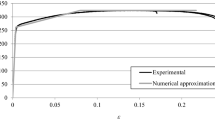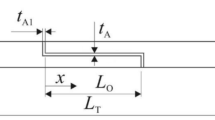Abstract
The use of the hybrid joint has increased in recent years because of its superior mechanical characteristics. In this study, quasistatic experiments were performed to elucidate the failure mechanism of hybrid composite joints upon consideration of the properties of the adhesive, clamping force, and joint width. The results showed that the stiffness of the adhesive is the most important design parameter. In this study, two adhesives with different stiffness values were used. In the case of the joints using the adhesive with the lower stiffness modulus, it was observed that the load was transferred readily through the adhesive since it was shared between the bolt and adhesive more efficiently. This phenomenon allowed the hybrid joints that use the low-modulus adhesive to sustain greater loads before failure, as compared to the joints that use the stiffer adhesive.
Similar content being viewed by others
References
L. J. Hart-smith, J. Aircr., 22, 993 (1985).
G. Kelly, Compos. Struct., 72, 119 (2006).
L. J. Hart-smith in “Fibrous Composites in Structural Design” (E. M. Lenoe, D. W. Oplinger, and J. J. Burke Eds.), pp.543–574, Springer US, New York, 1980.
J. P. Waszczak and T. A. Cruse, J. Compos Mater., 5, 421 (1971).
D. W. Oplinger and K. R. Gandhi, Proceedings of the Army Symposium on Solid Mechanics, pp.74–78 (1974).
Whitney, J. Ma, and R. J. Nuismer, J. Compos. Mater., 8, 253 (1974).
R. J. Nuismer and Whitney, Fracture Mechanics of Composites, ASTM International, 1975.
F. Chang, R. A. Scott, and S. George, J. Compos Mater., 16, 470 (1982).
F. Chang, R. A. Scott, and S. George, J. Compos. Mater., 18, 255 (1984).
EI. Schvechkov, Masinovedenie, 2, 71 (1984).
S. Venkateswarlu and K. Rajasekhar, “IOSR Journal of Mechanical and Civil Engineering IOSR-JMCE”, Vol. 6, pp.1–6, e-ISSN: 2278-1684, 2013.
A. Pirondi and F. Moroni, J. Adhes. Sci. Technol., 23, 1547 (2009).
T. N. Chakherlou, B. Abazadeh, and J. Vogwell, Eng. Fail. Anal, 16, 242 (2009).
Ciriscioli, R. Peter, Q. Wang, and S. George, J. Compos. Mater., 26, 90 (1992).
ISO 898-1, “Mechanical Properties of Fasteners Made of Carbon Steel and Alloy Steel. International Organization for Standardization”, 2013.
Author information
Authors and Affiliations
Corresponding author
Rights and permissions
About this article
Cite this article
Choi, JI., Hasheminia, S.M., Chun, HJ. et al. Experimental study on failure mechanism of hybrid composite joints with different adhesives. Fibers Polym 18, 569–574 (2017). https://doi.org/10.1007/s12221-017-1148-z
Received:
Revised:
Accepted:
Published:
Issue Date:
DOI: https://doi.org/10.1007/s12221-017-1148-z




